Swirling Flameless Combustion of Pure Ammonia Fuel
Abstract
1. Introduction
- Lower peak temperature significantly reduces thermal NOx formation, a major concern in ammonia combustion due to its high nitrogen content.
- The strong recirculation and thorough mixing in flameless combustion can help to address ammonia’s low reactivity by providing longer residence times and higher radical species supply.
- The uniform and high temperature distribution promotes complete combustion of ammonia, reducing emissions of unburned fuel.
2. Experimental Conditions and Methods
2.1. Experimental Setup
2.2. Experimental Conditions
3. Numerical Simulation
3.1. Fluid Dynamics and Heat Transfer Model
3.2. Numerical and Kinetic Modeling
3.2.1. EDC Model Implementation and Numerical Setup
3.2.2. Simplified Chemical Kinetic Mechanism for Ammonia Combustion
3.3. Computational Mesh Analysis
4. Results and Discussion
4.1. Experimental Results
4.2. Results of CFD Simulation
4.3. Comparison of CFD Models with Experiment Regarding NO Emissions
5. Conclusions
Author Contributions
Funding
Data Availability Statement
Conflicts of Interest
Abbreviations
| FLOX | Flameless Oxidation |
| CFD | Computational Fluid Dynamics |
| DAQ | Data Acquisition |
| DOM | Discrete Ordinates Model |
| EDC | Eddy Dissipation Concept |
| ER | Equivalence Ratio |
| GCI | Grid Convergence Index |
| HNO | Nitroxyl |
| ISAT | In Situ Adaptive Tabulation |
| LPG | Liquefied Petroleum Gas |
| MILD | Moderate or Intense Low-oxygen Dilution |
| NO | Nitric Oxide |
| RAI | Reverse Air Injection |
| RANS | Reynolds-Averaged Navier–Stokes |
| RR | Recirculation Ratio |
| TC | Thermocouple |
| TROE | Troe pressure-dependence formalism |
| WSGGM | Weighted Sum of Gray Gases Model |
References
- Ariemma, G.B.; Sorrentino, G.; Ragucci, R.; de Joannon, M.; Sabia, P. Ammonia/Methane combustion: Stability and NOx emissions. Combust. Flame 2022, 241, 112071. [Google Scholar] [CrossRef]
- Sánchez-Bastardo, N.; Schlögl, R.; Ruland, H. Methane pyrolysis for zero-emission hydrogen production: A potential bridge technology from fossil fuels to a renewable and sustainable hydrogen economy. Ind. Eng. Chem. Res. 2021, 60, 11855–11881. [Google Scholar] [CrossRef]
- Dincer, I.; Aydin, M.I. New paradigms in sustainable energy systems with hydrogen. Energy Convers. Manag. 2023, 283, 116950. [Google Scholar] [CrossRef]
- Muthukumar, P.; Kumar, A.; Afzal, M.; Bhogilla, S.; Sharma, P.; Parida, A.; Jana, S.; Kumar, E.A.; Pai, R.K.; Jain, I. Review on large-scale hydrogen storage systems for better sustainability. Int. J. Hydrogen Energy 2023, 48, 33223–33259. [Google Scholar] [CrossRef]
- Yousefi Rizi, H.A.; Shin, D. Green hydrogen production technologies from ammonia cracking. Energies 2022, 15, 8246. [Google Scholar] [CrossRef]
- Chehade, G.; Dincer, I. Progress in green ammonia production as potential carbon-free fuel. Fuel 2021, 299, 120845. [Google Scholar] [CrossRef]
- Valera-Medina, A.; Xiao, H.; Owen-Jones, M.; David, W.I.; Bowen, P. Ammonia for power. Prog. Energy Combust. Sci. 2018, 69, 63–102. [Google Scholar] [CrossRef]
- Nur-E-Alam, M.; Mostofa, K.Z.; Yap, B.K.; Khairul, M.; Das, N.; Kiong, T.S. Machine learning-enhanced all-photovoltaic blended systems for energy-efficient sustainable buildings. Sustain. Energy Technol. Assess. 2024, 62, 103636. [Google Scholar] [CrossRef]
- Peters, R.; Pasel, J.; Samsun, R.C. Technology transfer from fuel processing for fuel cells to fuel synthesis from hydrogen and carbon dioxide. Int. J. Hydrogen Energy 2024, 49, 943–961. [Google Scholar] [CrossRef]
- Ristig, S.; Poschmann, M.; Folke, J.; Gómez-Cápiro, O.; Chen, Z.; Sanchez-Bastardo, N.; Schlögl, R.; Heumann, S.; Ruland, H. Ammonia decomposition in the process chain for a renewable hydrogen supply. Chem. Ing. Technol. 2022, 94, 1413–1425. [Google Scholar] [CrossRef]
- Jindal, A.; Shrimali, G. At-scale adoption of battery storage technology in Indian power industry: Enablers, frameworks and policies. Technol. Forecast. Soc. Change 2022, 176, 121467. [Google Scholar] [CrossRef]
- Park, Y.-K.; Kim, B.-S. Catalytic removal of nitrogen oxides (NO, NO2, N2O) from ammonia-fueled combustion exhaust: A review of applicable technologies. Chem. Eng. J. 2023, 461, 141958. [Google Scholar] [CrossRef]
- Elbaz, A.M.; Wang, S.; Guiberti, T.F.; Roberts, W.L. Review on the recent advances on ammonia combustion from the fundamentals to the applications. Fuel Commun. 2022, 10, 100053. [Google Scholar] [CrossRef]
- Kobayashi, H.; Hayakawa, A.; Somarathne, K.K.A.; Okafor, E.C. Science and technology of ammonia combustion. Proc. Combust. Inst. 2019, 37, 109–133. [Google Scholar] [CrossRef]
- Yousefi Rizi, H.A.; Shin, D. Development of ammonia combustion technology for NOx reduction. Energies 2025, 18, 1248. [Google Scholar] [CrossRef]
- Zel’dovich, I.A.; Barenblatt, G.I.; Librovich, V.; Makhviladze, G. Mathematical Theory of Combustion and Explosions; Consultants Bureau: New York, NY, USA, 1985. [Google Scholar]
- Li, T.; Duan, Y.; Wang, Y.; Zhou, M.; Duan, L. Research progress of ammonia combustion toward low-carbon energy. Fuel Process. Technol. 2023, 248, 107821. [Google Scholar] [CrossRef]
- Cai, T.; Zhao, D. Overview of auto-ignition and flame propagation properties for ammonia combustion. AIAA J. 2023, 61, 2754–2778. [Google Scholar] [CrossRef]
- Tian, J.; Wang, L.; Xiong, Y.; Wang, Y.; Yin, W.; Tian, G.; Wang, Z.; Cheng, Y.; Ji, S. Enhancing combustion efficiency and reducing nitrogen oxide emissions from ammonia combustion: A comprehensive review. Process Saf. Environ. Prot. 2024, 183, 1–17. [Google Scholar] [CrossRef]
- Ma, F.; Guo, L.; Li, Z.; Zeng, X.; Zheng, Z.; Li, W.; Zhao, F.; Yu, W. A review of current advances in ammonia combustion from the fundamentals to applications in internal combustion engines. Energies 2023, 16, 6304. [Google Scholar] [CrossRef]
- Zięba, M. Experimental and Modelling Studies on Fuel-NOx Formation During Flameless Combustion of Biogenous Fuels. Ph.D. Thesis, University of Stuttgart, Stuttgart, Germany, 2023. [Google Scholar]
- Li, P.-W.; Chyang, C.-S.; Ni, H.-W. An experimental study of the effect of nitrogen origin on the formation and reduction of NOx in fluidized-bed combustion. Energy 2018, 154, 319–327. [Google Scholar] [CrossRef]
- Gheidan, A.A.; Wahid, M.B.A.; Opia, A.C. Flameless combustion mode as a promising trend: A review on its fundamental role towards emissions reduction, fuel consumption and performance enhancement. AIP Conf. Proc. 2023, 2432, 020001. [Google Scholar] [CrossRef]
- Dimitriou, P.; Javaid, R.A. A review of ammonia as a compression-ignition engine fuel. Int. J. Hydrogen Energy 2020, 45, 7098–7118. [Google Scholar] [CrossRef]
- Zieba, M.; Brink, A.; Schuster, A.; Hupa, M.; Scheffknecht, G. Ammonia chemistry in a flameless jet. Combust. Flame 2009, 156, 1950–1956. [Google Scholar] [CrossRef]
- Ariemma, G.B.; Sabia, P.; Sorrentino, G.; Bozza, P.; de Joannon, M.; Ragucci, R. Influence of water addition on MILD ammonia combustion performances and emissions. Proc. Combust. Inst. 2021, 38, 5147–5154. [Google Scholar] [CrossRef]
- Jiang, W.; Zhu, R.; Shin, D. Heat transfer characteristics of tubular heat exchanger using reverse air injection flameless combustion. Appl. Therm. Eng. 2023, 230, 120713. [Google Scholar] [CrossRef]
- Zhu, R.; Shin, D. Study on flow and heat transfer characteristics of 25 kW flameless combustion in a cylindrical heat exchanger for a reforming processor. Energies 2023, 16, 7160. [Google Scholar] [CrossRef]
- Choi, C.; Kim, W.; Shin, D. Combustion characteristics by reversed air injection as a flameless combustion. J. Mech. Sci. Technol. 2017, 31, 1593–1601. [Google Scholar]
- Okafor, E.C.; Somarathne, K.K.A.; Hayakawa, A.; Kudo, T.; Kurata, O.; Iki, N.; Kobayashi, H. Towards the development of an efficient low-NOx ammonia combustor for a micro gas turbine. Proc. Combust. Inst. 2019, 37, 4597–4606. [Google Scholar] [CrossRef]
- Somarathne, K.D.K.A.; Hatakeyama, S.; Hayakawa, A.; Kobayashi, H. Numerical study of a low-emission gas-turbine-like combustor for turbulent ammonia/air premixed swirl flames with a secondary air injection at high pressure. Int. J. Hydrogen Energy 2017, 42, 27388–27399. [Google Scholar] [CrossRef]
- Oh, N.; Shin, J.; Jeon, B.; Choi, C.; Shin, D. Development of a flameless furnace with swirling reversed air injection method. In Proceedings of the International Conference of Aerospace and Mechanical Engineering 2019: AeroMech 2019, Pulau Pinang, Malaysia, 20–21 November 2019; Springer: Singapore, 2020; pp. 233–247. [Google Scholar]
- Abuelnuor, A.; Wahid, M.; Hosseini, S.E.; Saat, A.; Saqr, K.M.; Sait, H.H.; Osman, M. Characteristics of biomass in flameless combustion: A review. Renew. Sustain. Energy Rev. 2014, 33, 363–370. [Google Scholar] [CrossRef]
- Borghi, R.; Destriau, M. Combustion and Flames: Chemical and Physical Principles; Eyrolles: Paris, France, 1998. [Google Scholar]
- Bowman, C.T. An experimental and analytical investigation of the high-temperature oxidation mechanisms of hydrocarbon fuels. Combust. Sci. Technol. 1970, 2, 161–172. [Google Scholar] [CrossRef]
- Guillou, E. Flame Characteristics and Application of Flameless Combustion. Ph.D. Thesis, University of Cincinnati, Cincinnati, OH, USA, 2008. [Google Scholar]
- Zhang, X.; Moosakutty, S.P.; Rajan, R.P.; Younes, M.; Sarathy, S.M. Combustion chemistry of ammonia/hydrogen mixtures: Jet-stirred reactor measurements and comprehensive kinetic modeling. Combust. Flame 2021, 234, 111653. [Google Scholar] [CrossRef]
- Udochukwu, G.O.; Vyacheslav, A. Reynolds-averaged Navier–Stokes (RANS) simulation of a staged pressurized oxy-coal combustion (SPOC). Proc. West Va. Acad. Sci. 2019, 91, 1–11. [Google Scholar] [CrossRef]
- Tusar, M.; Noman, A.; Islam, M.; Yarlagadda, P.; Salam, B. CFD study of heat transfer enhancement and fluid flow characteristics of turbulent flow through tube with twisted-tape inserts. Energy Procedia 2019, 160, 715–722. [Google Scholar] [CrossRef]
- Chen, Y.-S.; Kim, S.-W. Computation of Turbulent Flows Using an Extended k–ε Turbulence Closure Model; NASA Contractor Report 179204; NASA: Washington, DC, USA, 1987.
- Nguyen, P.D.; Ghazal, G.; Piñera, V.C.; Battaglia, V.; Rensgard, A.; Ekman, T.; Gazdallah, M. Modelling of flameless oxy-fuel combustion with emphasis on radiative heat transfer for low calorific-value blast-furnace gas. Energy Procedia 2017, 120, 492–499. [Google Scholar] [CrossRef]
- Fiveland, W.A. Discrete-ordinates solutions of the radiative transport equation for rectangular enclosures. J. Quant. Spectrosc. Radiat. Transfer 1984, 31, 63–80. [Google Scholar] [CrossRef]
- Parente, A.; Malik, M.R.; Contino, F.; Cuoci, A.; Dally, B.B. Extension of the Eddy Dissipation Concept for turbulence/chemistry interactions to MILD combustion. Fuel 2016, 163, 98–111. [Google Scholar] [CrossRef]
- Mousavi, S.M.; Sotoudeh, F.; Jun, D.; Lee, B.J.; Esfahani, J.A.; Karimi, N. On the effects of NH3 addition to a reacting mixture of H2/CH4 under MILD combustion regime: Numerical modeling with a modified EDC combustion model. Fuel 2022, 326, 125096. [Google Scholar] [CrossRef]
- Pope, S.B. Computationally efficient implementation of combustion chemistry using in-situ adaptive tabulation. Combust. Theory Model. 1997, 1, 41–63. [Google Scholar] [CrossRef]
- Duynslaegher, C.; Contino, F.; Vandooren, J.; Jeanmart, H. Modeling of ammonia combustion at low pressure. Combust. Flame 2012, 159, 2799–2805. [Google Scholar] [CrossRef]
- Troe, J. Theory of thermal unimolecular reactions at low pressures. I. Solutions of the master equation. J. Chem. Phys. 1977, 66, 4745–4757. [Google Scholar] [CrossRef]
- Mansour, A.; Laurien, E. Numerical error analysis for three-dimensional CFD simulations in the two-room model containment THAI +: Grid-convergence index, wall-treatment error and scalability tests. Nucl. Eng. Des. 2018, 326, 220–233. [Google Scholar] [CrossRef]
- Hayakawa, A.; Arakawa, Y.; Mimoto, R.; Somarathne, K.K.A.; Kudo, T.; Kobayashi, H. Experimental investigation of stabilization and emission characteristics of ammonia/air premixed flames in a swirl combustor. Int. J. Hydrogen Energy 2017, 42, 14010–14018. [Google Scholar] [CrossRef]
- Aminian, J.; Galletti, C.; Shahhosseini, S.; Tognotti, L. Key modeling issues in prediction of minor species in diluted-preheated combustion conditions. Appl. Therm. Eng. 2011, 31, 3287–3300. [Google Scholar] [CrossRef]
- Xiao, H.; Valera-Medina, A.; Bowen, P.J. Modeling combustion of ammonia/hydrogen fuel blends under gas-turbine conditions. Energy Fuels 2017, 31, 8631–8642. [Google Scholar] [CrossRef]
- Wünning, J.A.; Wünning, J.G. Flameless oxidation to reduce thermal NO-formation. Prog. Energy Combust. Sci. 1997, 23, 81–94. [Google Scholar] [CrossRef]
- Miller, J.A.; Bowman, C.T. Mechanism and modeling of nitrogen chemistry in combustion. Prog. Energy Combust. Sci. 1989, 15, 287–338. [Google Scholar] [CrossRef]

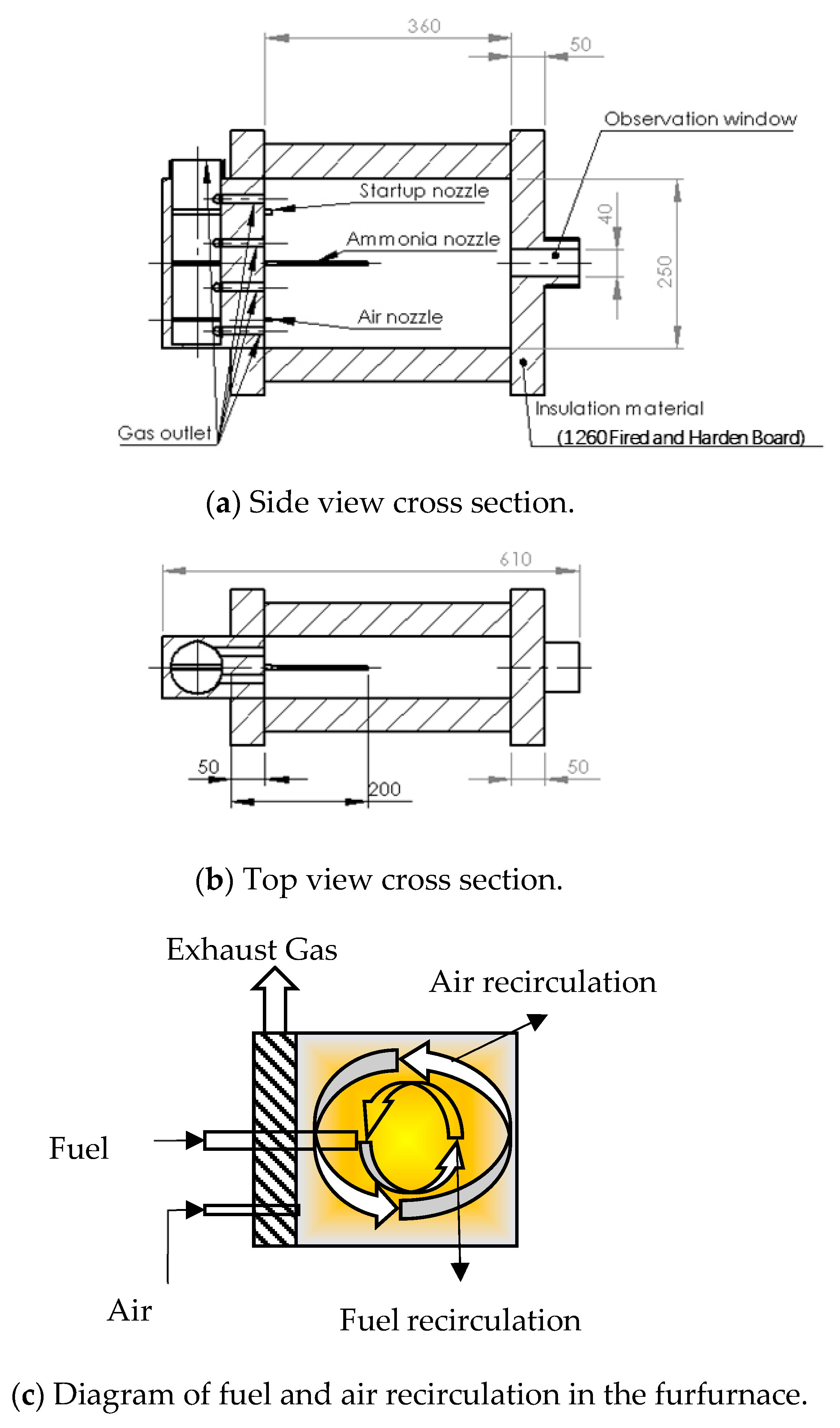
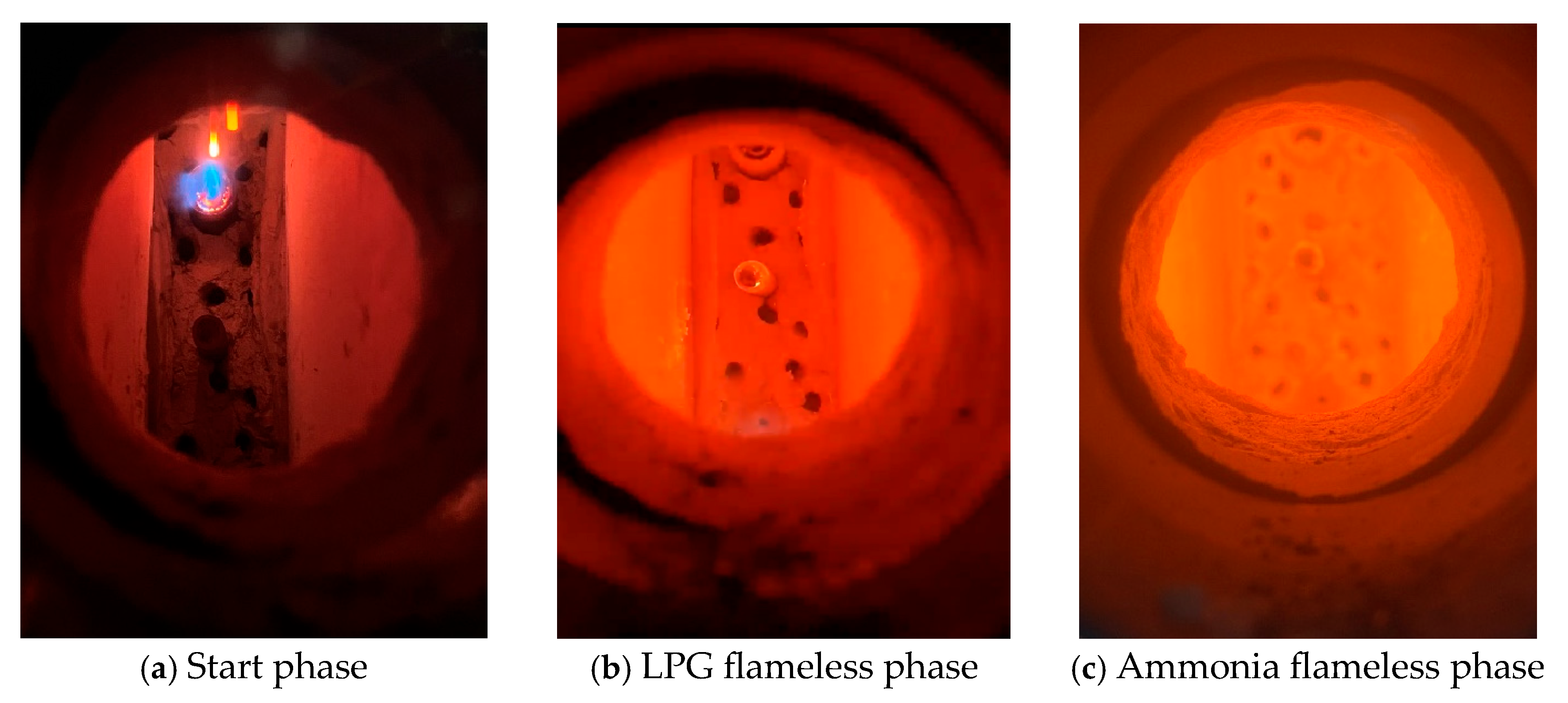
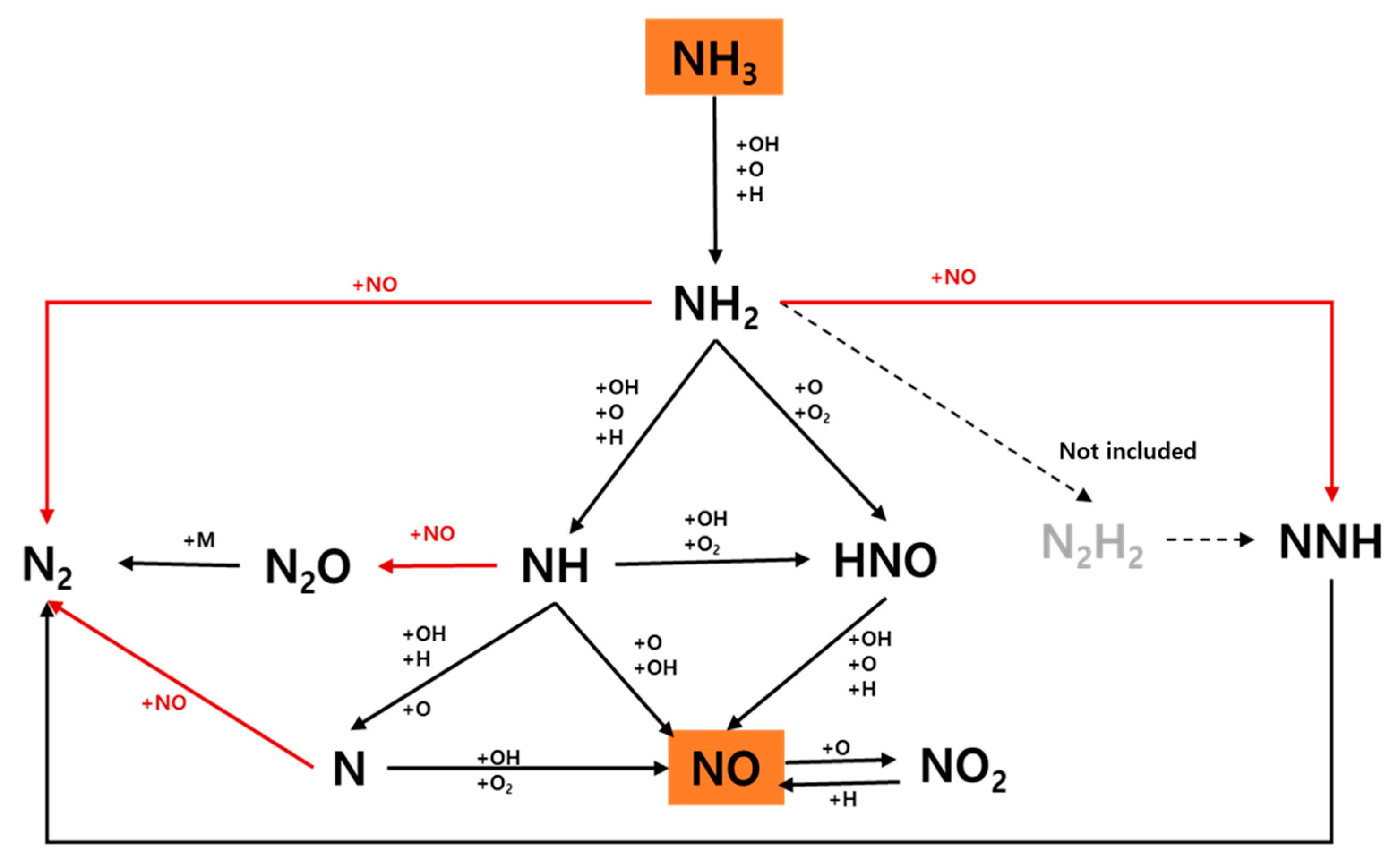
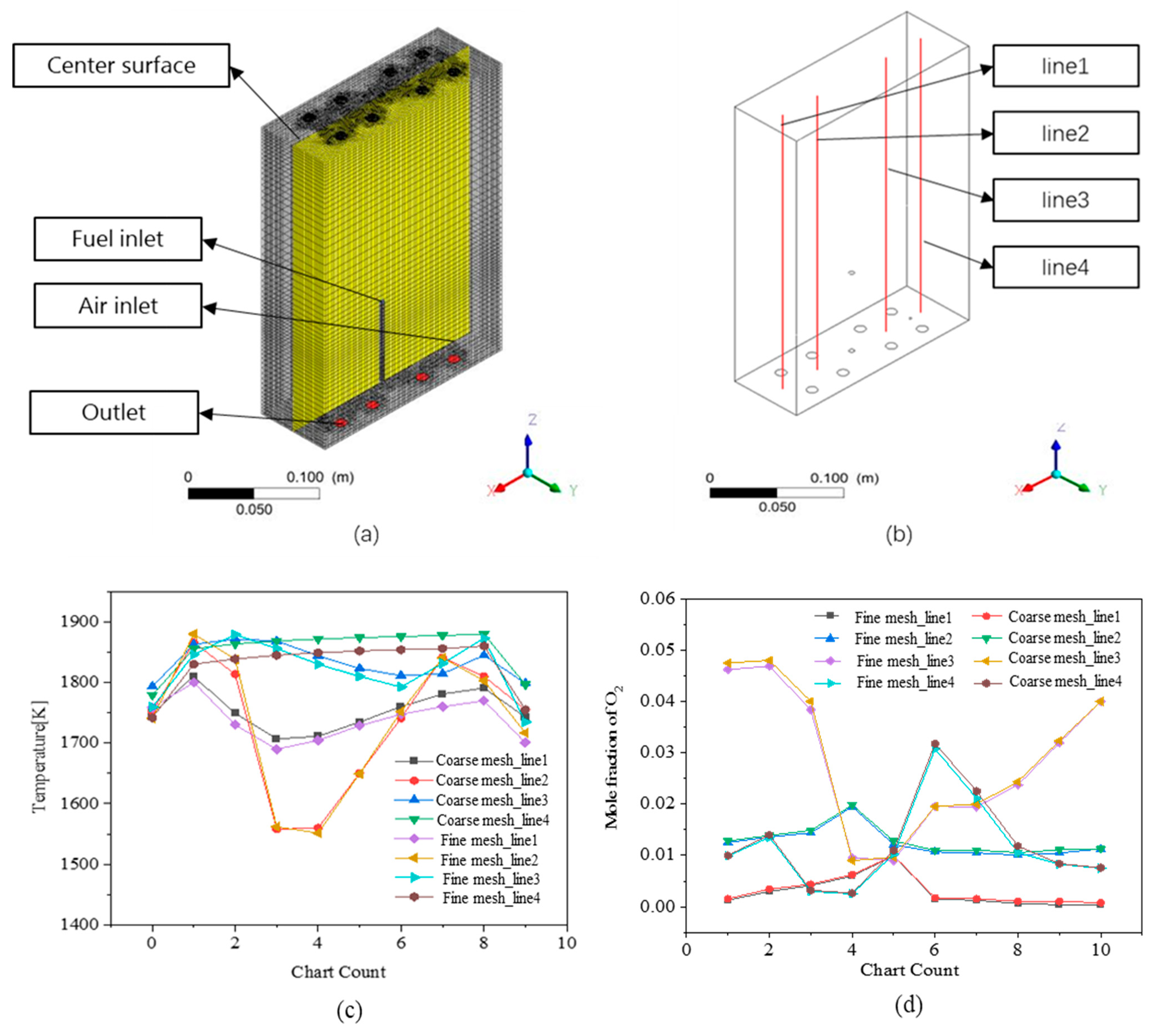
 : selected points for simulation analysis).
: selected points for simulation analysis).
 : selected points for simulation analysis).
: selected points for simulation analysis).

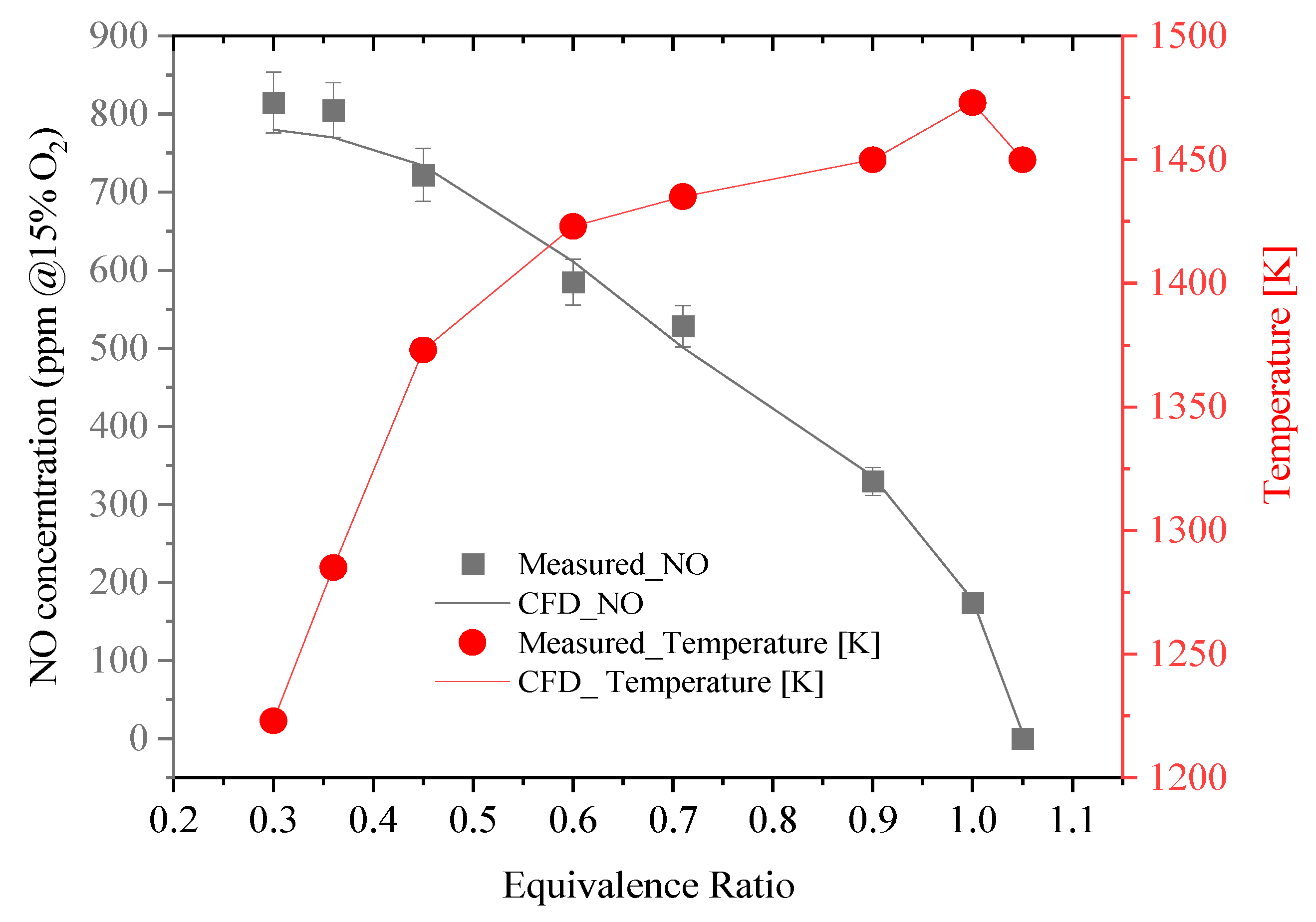
| Measurement Target | Instrument |
|---|---|
| Furnace temperature distribution | DAQ (Yokogawa MV2000, Tokyo, Japan)/K-type thermo-couples (T max = 1360 °C, precision: ±1 °C) |
| Chemical species (O2, NO) | Testo 330-LL (Testo SE & Co. KGaA, Lenzkirch, Germany) (O2: 0–25% ± 0.1%, NO: 0–3000 ppm ±0.5%,) (electrochemical sensors) |
| Chemical species (H2) | MRU SWG 200-1 (MRU Instruments Inc., Neckarsulm, Germany) (0–100% ± 1%) (NDIR: non-dispersive infrared sensor) |
| Chemical species (NH3) | CLD844 CM h (Multi Instruments Analytical, Breda, The Netherlands) (0~5000 ppm ± 0.1%) (electrochemical sensor) |
| Case | Air Flow Rate [lpm] | Fuel Flow Rate [lpm] | Outlet O2 Concentration (Measured) [%] | Air Jet Velocity [m/s] | Equivalence Ratio |
|---|---|---|---|---|---|
| 1 | 34 | 10 | 0 | 80 | 1.05 |
| 2 | 36 | 10 | 1 | 85 | 1.00 |
| 3 | 40 | 10 | 3.3 | 91 | 0.9 |
| 4 | 50 | 10 | 7 | 118 | 0.71 |
| 5 | 60 | 10 | 9.8 | 142 | 0.60 |
| 6 | 80 | 10 | 13.3 | 189 | 0.45 |
| 7 | 100 | 10 | 15.4 | 235 | 0.36 |
| 8 | 120 | 10 | 16.3 | 283 | 0.30 |
| Continuity equation: | (4) | |
| Momentum Conservation Equation | (5) | |
| Turbulent kinetic energy : | (6) | |
| Dissipation : | (7) | |
| Energy equation: | (8) | |
| Discrete ordinates (DO) radiation model: | (9) | |
| Species transport: | (10) |
| Thermophysical Properties | Values |
|---|---|
| Specific gravity | 0.597 (1.013 bar at 21 °C) (air = 1) |
| Specific volume | 1.411 m3/kg (1.013 bar at 21 °C) |
| Specific heat at constant pressure (cp) | 0.037 kJ/(mol·K) (1.013 bar at 15 °C) |
| Specific heat at constant volume (cv) | 0.028 kJ/(mol·K) (1.013 bar at 15 °C) |
| Ratio of specific heats (cp/cv) | 1.309623 (1.013 bar at 15 °C) |
| Dynamic viscosity | 0.000098 Poise (1.013 bar at 0 °C) |
| Thermal conductivity | 22.19 mW/(m·K) (1.013 bar at 0 °C) |
| Autoignition temperature | 630 °C |
| Ignition temperature | 651 °C |
| Number | Reactions | (cal/mole) | Others | ||
|---|---|---|---|---|---|
| R1 | NH3 + M = NH2 + H + M | 2.20 × 1016 | 0.00 × 100 | 9.35 × 104 | - |
| R2 | NH3 + H = NH2 + H2 | 5.42 × 105 | 2.40 × 100 | 9.92 × 103 | - |
| R3 | NH3 + O = NH2 + OH | 1.10 × 106 | 2.10 × 100 | 5.21 × 103 | - |
| R4 | NH3 + OH = NH2 + H2O | 5.00 × 107 | 1.60 × 100 | 9.50 × 102 | - |
| R5 | NH2 + M = NH + H + M | 3.16 × 1023 | −2.00 × 100 | 9.14 × 104 | - |
| R6 | NH2 + H = NH + H2 | 1.00 × 106 | 2.32 × 100 | 7.99 × 102 | - |
| R7 | NH2 + O = NH + OH | 7.00 × 1012 | 0.00 × 100 | 0.00 × 100 | - |
| R8 | NH2 + OH = NH + H2O | 9.00 × 107 | 1.50 × 100 | −4.60 × 102 | - |
| R9 | NH2 + O = HNO + H | 4.50 × 1013 | 0.00 × 100 | 0.00 × 100 | - |
| R10 | NH2 + O2 = HNO + OH | 1.00 × 1013 | 0.00 × 100 | 2.63 × 104 | - |
| R11 | NH2 + NO = N2 + H2O | 2.77 × 1020 | −2.65 × 100 | 1.26 × 103 | - |
| R12 | NH2 + NO = H2 + N2O | 1.00 × 1013 | 0.00 × 100 | 3.37 × 104 | - |
| R13 | NH + H = N + H2 | 3.20 × 1013 | 0.00 × 100 | 3.25 × 102 | - |
| R14 | NH + O = NO + H | 7.00 × 1013 | 0.00 × 100 | 0.00 × 100 | - |
| R15 | NH + O = N + OH | 7.00 × 1012 | 0.00 × 100 | 0.00 × 100 | - |
| R16 | NH + OH = HNO + H | 2.00 × 1013 | 0.00 × 100 | 0.00 × 100 | - |
| R17 | NH + OH = NO + H2 | 2.00 × 1013 | 0.00 × 100 | 0.00 × 100 | - |
| R18 | NH + O2 = HNO + O | 4.00 × 1013 | 0.00 × 100 | 1.79 × 104 | - |
| R19 | NH + O2 = NO + OH | 4.50 × 108 | 7.90 × 10−1 | 1.19 × 103 | - |
| R20 | NH + NO = N2O + H | 5.00 × 1014 | −4.00 × 10−1 | 0.00 × 100 | - |
| R21 | NH + NO = N2 + OH | 6.10 × 1013 | −5.00 × 10−1 | 1.20 × 102 | - |
| R22 | N + O2 = NO + O | 9.00 × 109 | 1.00 × 100 | 6.50 × 103 | - |
| R23 | N + OH = NO + H | 2.80 × 1013 | 0.00 × 100 | 0.00 × 100 | - |
| R24 | N + NO = N2 + O | 1.80 × 1014 | 0.00 × 100 | 7.61 × 104 | - |
| R25 | NO + O(+M) = NO2(+M) | 1.30 × 1015 | −7.50 × 10−1 | 0.00 × 100 | Low: 4.72 × 1024/−2.87/1.55 × 103 TROE: 9.62 × 10−1/101/7960 Ar/0.6/NO2/6.2/NO/1.8/O2/0.8/N2O/4.4/H2O/10/ |
| R26 | H + NO(+M) = HNO(+M) | 1.52 × 1015 | −4.10 × 10−1 | 0.00 × 100 | Low: 4.00 × 1020/−1.75/0 H2O/10/O2/1.5/Ar/0.75/H2/2/ |
| R27 | HNO + H = NO + H2 | 4.46 × 1011 | 7.20 × 10−1 | 6.55 × 102 | - |
| R28 | HNO + OH = NO + H2O | 1.30 × 107 | 1.88 × 100 | −9.56 × 102 | - |
| R29 | HNO + O = OH + NO | 5.00 × 1011 | 5.00 × 10−1 | 2.00 × 103 | - |
| R30 | NNH = N2 + H | 3.00 × 108 | 0.00 × 100 | 0.00 × 100 | - |
| R31 | H + HO2 = OH + OH | 1.70 × 1014 | −1.00 × 100 | 8.75 × 102 | |
| R32 | H + O2 = OH + O | 9.75 × 1013 | −1.30 × 100 | 1.49 × 104 | - |
| R33 | O2 + M = O + O + M | 1.00 × 1017 | −1.00 × 100 | 0.00 × 100 | O/71/O2/20/NO/5/N2/5/N/5/H2O/5/ |
| R34 | O + H2 = OH + H | 5.06 × 104 | 2.67 × 100 | 6.29 × 103 | - |
| R35 | H + O2(+M) = HO2(+M) | 1.48 × 1012 | 6.00 × 10−1 | 0.00 × 100 | Low: 3.50 × 1016/−0.41/−1.12 × 103 TROE: 0.5/1.00 × 105/10 H2O/10.6/H2/1.5/ |
| R36 | N2O(+M) = N2 + O(+M) | 1.26 × 1012 | 0.00 × 100 | 6.26 × 104 | Low: 4.00 × 1014/0.00/5.66 × 104 O2/1.4/N2/1.7/H2O/12/NO/3/N2O/3.5/ |
Disclaimer/Publisher’s Note: The statements, opinions and data contained in all publications are solely those of the individual author(s) and contributor(s) and not of MDPI and/or the editor(s). MDPI and/or the editor(s) disclaim responsibility for any injury to people or property resulting from any ideas, methods, instructions or products referred to in the content. |
© 2025 by the authors. Licensee MDPI, Basel, Switzerland. This article is an open access article distributed under the terms and conditions of the Creative Commons Attribution (CC BY) license (https://creativecommons.org/licenses/by/4.0/).
Share and Cite
Qin, L.; Yousefi Rizi, H.A.; Jeon, B.; Shin, D. Swirling Flameless Combustion of Pure Ammonia Fuel. Energies 2025, 18, 3104. https://doi.org/10.3390/en18123104
Qin L, Yousefi Rizi HA, Jeon B, Shin D. Swirling Flameless Combustion of Pure Ammonia Fuel. Energies. 2025; 18(12):3104. https://doi.org/10.3390/en18123104
Chicago/Turabian StyleQin, Lizhen, Hossein Ali Yousefi Rizi, Byeongjun Jeon, and Donghoon Shin. 2025. "Swirling Flameless Combustion of Pure Ammonia Fuel" Energies 18, no. 12: 3104. https://doi.org/10.3390/en18123104
APA StyleQin, L., Yousefi Rizi, H. A., Jeon, B., & Shin, D. (2025). Swirling Flameless Combustion of Pure Ammonia Fuel. Energies, 18(12), 3104. https://doi.org/10.3390/en18123104








